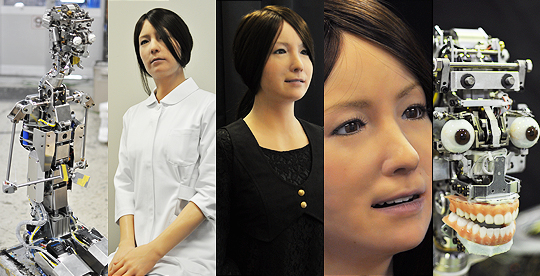And A Droid For Every Garage
Several years ago, I was watching a cartoon show called Cubix: Robots For Everyone. I watched it mainly because it came on right before The Jackie Chan Adventures. As I watched the program, I began to ponder why we don’t have robots like we see in science fiction. Things eventually became clear.
Though they might not be as ubiquitous as in the Star Wars universe, robots are everywhere. It becomes fairly obvious when we understand what robots are. Robots are machines which autonomously analyze and carry out tasks. Usually when we think of robots, we think of R2D2, C3PO, Lt. Commander Data, Cylons, The Terminator, The Robot from “Lost in Space”, and so on. But robots are often as simple as an automatic garage door opener or sliding doors at the supermarket. In fact, since some robots can be “piloted”, people drive their robots on city streets and highways all the time. (But we still call those units “cars”.)
So why is it that with all the decades of fascination with robots and promises of making our lives better do we not see massive amounts of robots like we see in the movies? Part of it is cost, and part of it is a lag in technology. But I think the main reason is because the robots which have been developed and put on the general consumer market have been utter and complete crap. It’s hard to mature a product that the consumer simply doesn’t want. For those of us who would love to see a robot-filled world, this is truly unfortunate.
But there’s hope. I have come up with a few guidelines for making robots for the general consumer market. These are guidelines which every robotics developer should heed.
1. Make it utilitarian
This cannot be overstated. If it doesn’t have a practical purpose, then it’s nothing more than a gimmick. R2D2 was a handidroid, C3PO was a protocol droid (translator), WALL-E picked up trash, etc. Sure they each had personalities, and that’s great. But robots are machines. They need to be developed and treated as such. After all, do you really think someone is going to buy a Blu-Ray player in order to have stimulating conversation with said device, or is that someone planning to do nothing more than play discs on it? If a robot becomes a friend, that’s fine. But that should never be the primary goal of a robot.
2. Open standards
One of the things that really boosts the widespread use of technology when they’re present and really frustrates people when they’re not is open standards. I like being able to hook a Panasonic video player into a Sony television and have them work together without the use of schematics and a soldering iron. Cars took off in the early days largely because they were something that could be tinkered with. Computers didn’t become omnipresent until IBM opened up its technology. Now even Apple is for the most part using that standard.
Let’s say I were to buy an R2 unit (with an R4 head, go figure) which blew up because of a bad motivator. Frankly, I didn’t know R2 units would commit suicide without proper motivation. If I wanted to replace the stock Anthony Robbins motivator with a Zig Ziglar motivator to prevent a depressed R2, then by golly, I should be able to do just that! (Does anyone say “by golly” anymore? Well by golly, I just did!)
And I should be able to diagnose and change parts in my R2 without an engineering degree. Imagine being able to change out parts on a robot in order to easily and completely alter its function as necessary. That battle droid you used to fend off the zombie apocalypse can serve drinks with a quick switch in a couple of parts and a few new instructions.
Open standards allow the consumer to customize, modify, upgrade, and even develop new technology not previously imagined by the original manufacturer. But right now, Lego robotics don’t work with Roombas. Doesn’t that suck?
3. The face and the interface
Then there’s the issue of interactivity. How people deal with their robots determines how effective that robot will ultimately be. There’s no point in a machine that nobody wants to deal with. This applies to both how the machine appears and how it behaves. If a user is uncomfortable with using a robot, then it defeats the purpose of having one in the first place.
Robot servants are something that one should be able to deal with casually. They should fit themselves seamlessly into everyday life, much like a microwave, television, computer, and so on. That means all controls and commands must be casual and simple, providing it doesn’t get confused with regular speech. But unfortunately, engineers love to use obscure and unnatural terminology. For instance, the word “apropos” would be completely vanquished from my vocabulary if it wasn’t a Unix shell command. Keep it simple. And if I have to open up JDK, GCC, or (Heaven forbid) NASM on my computer and actually have to write code to get a robot to do what I want, then God help me, I will get myself a sword and go completely Medieval on some robotics engineers! (“Hey Poindexter! Time for a savings throw and you have no dice! Prepare to eat Claymore!!”)
And robots must look like robots. This cannot be overstated. Researchers at the University of California San Diego recently found that true androids, the human-looking ones, tend to freak people out. They concluded that it causes conflict in the human mind. They showed test subjects footage of the realistic Japanese Repliee Q2 robot doing human-like tasks. They were completely spooked.
So a robot should appear robotic. And it should be cute, but not too cute. On one hand, people don’t want to have their windows washed by the Terminator. But on the other hand, unless you’re making a robot for preteen girls, it probably shouldn’t look like a Furby. The rule of thumb is that it should be pleasing to the eye, but not distracting. Honda’s Asimo is a good start. Better yet, think Star Wars.
If only robotics developers would heed these guidelines, then maybe, just maybe, we can have the robot-infused world that we were all promised by the year 2000 … over a decade late.
[Main photo set: Geminoid F, Osaka University]
![]()





Reblogged this on Daniel C. Handley and commented:
Written for SciFi4Me.com